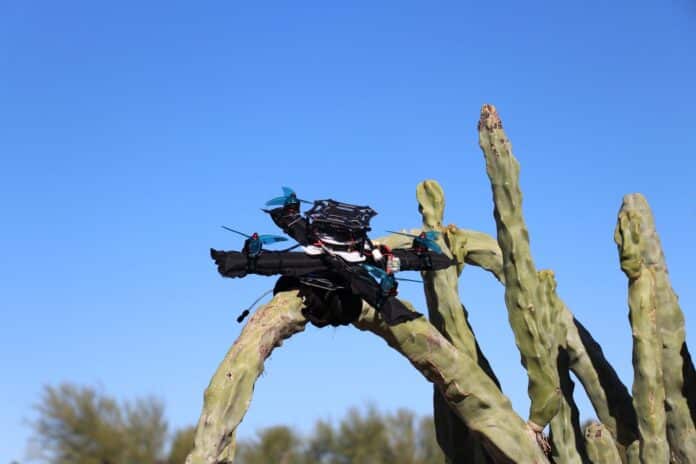Current aerial robots demonstrate limited interaction capabilities in unstructured environments when compared with their biological counterparts. For example, their inability to tolerate collisions and to successfully land or perch on objects of unknown shapes, sizes, and textures.
Efforts to include compliance have introduced designs that incorporate external mechanical impact protection at the cost of reduced agility and flight time due to the added weight.
Now, scientists at Arizona State University have developed a lightweight, soft-bodied aerial robot (SoBAR) with an inflatable frame to enable resilience to collisions and an innovative gripper that enables the device to securely perch on almost any surface. Uniquely, its stiffness is tunable or adjustable to absorb and recover from unexpected taps and thumps.
“We need to change our focus on avoiding environmental contact. Drones need to physically interact with their surroundings to accomplish a range of tasks,” says Wenlong Zhang, an associate professor and robotics expert at the Ira A. Fulton Schools of Engineering at Arizona State University. “A soft body not only absorbs impact forces to provide collision resilience; it also offers the material compliance necessary for dynamic maneuvers such as perching.”
Perching is an example of controlled collision. Birds technically collide with tree branches or other structures as they land and perch. Their compliant joints and soft tissues absorb the impact force, and a passive locking mechanism in their feet enables them to grasp onto irregular surfaces without using muscular energy to hold them in place.
The team drew inspiration from this avian model to design a hybrid fabric-based bistable grasper for their new aerial drone. Bistable means it has two unpowered resting states: open and closed. It simply reacts to the impact of landing by snapping closed and securely gripping onto objects of various shapes and sizes.
“It can perch on pretty much anything. Also, the bistable material means it doesn’t need an actuator to provide power to hold its perch. It just closes and stays like that without consuming any energy,” Zhang says. “Then, when needed, the gripper can be pneumatically retracted, and the drone can just take off.”
Unlike the conventional rigid aerial robots, SoBAR successfully demonstrates its ability to repeatedly endure and recover from collisions in various directions, not only limited to in-plane ones. Furthermore, we exploit its capabilities to demonstrate perching where the three-dimensional collision resilience helps in improving the perching success rates.
Such contact-reactive, unpowered perching is important for sustained operations in the field. Drones can position themselves wherever required and then turn off their rotors to conserve battery power. Researchers say such dynamic environmental interaction can enhance the use of drones in search and rescue operations, but also for other purposes such as monitoring forest fires, aiding military reconnaissance, and even exploring the surface of other planets.
“There are so many functionalities possible with conformable, reconfigurable soft aerial robots, so we hope our work here leads to even more novel, bio-inspired designs,” Zhang says.
Journal reference:
- Pham H. Nguyen, Karishma Patnaik, Shatadal Mishra, Panagiotis Polygerinos, and Wenlong Zhang. A Soft-Bodied Aerial Robot for Collision Resilience and Contact-Reactive Perching. Soft Robotics, 2023; DOI: 10.1089/soro.2022.0010
